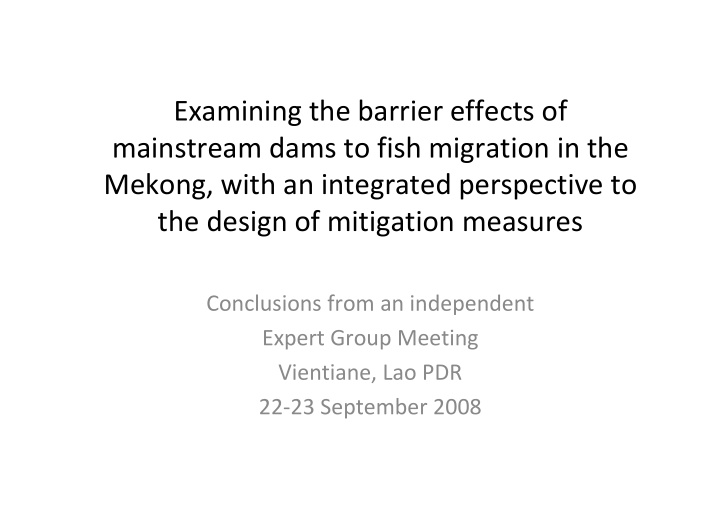



Examining the barrier effects of mainstream dams to fish migration in the Mekong, with an integrated perspective to the design of mitigation measures Conclusions from an independent Expert Group Meeting Vientiane, Lao PDR 22 ‐ 23 September 2008
Key messages 1. Mekong fisheries, migration, and dams 2. Mitigation – main conclusions from existing science 3. Mitigation – experience from specific technologies in other countries
The Mekong has the world’s largest inland fisheries Lower Mekong Middle Mekong Upper Mekong 1 ‐ 1.3million tonnes 0.9 ‐ 1.2 million tonnes 60,000 tonnes Lower Mekong system Middle Mekong system Upper Mekong system
Mekong fisheries are valuable US$ • > US$ 3 billion per annum Income • Tonle Sap ‐ 80% of people fish • Lao PDR > 50% fish; 80% in south (20% household income) Nutrition • 60 million people in LMB • Fish – main source of animal protein + micro nutrients • Per capita consumption 29 ‐ 39 kg p.a.
Mekong fisheries are dependent on migration over large and short distances More than 70% of total fish catch in the lower Mekong basin (> 1.3 million tonnes worth US$2.5 billion) is dependent on long distance migrants
Dams are a barrier to fish migration Effect varies depending on: species + location + design + operation of dam Impact of dams on mainstream is greater than impact of dams on tributaries Dams that stop migration in the middle and lower LMB will have a greater impact on fish production than dams in the upper LMB
Mitigation – main conclusions from existing science • Existing fish passage facilities cannot cope with large fish migrations and high species biodiversity – as found in the Mekong • North America and Europe – 5 ‐ 8 species (Salmonids) • Mekong ‐ 50 species (biomass 100x) • Dams in the middle + lower part of LMB = major fisheries + economic + social impacts • Best to address this issue by building dams higher in the basin – or on tributaries
Mitigation – learning from technologies in other countries Columbia River, USA Spillway Passage Turbine Passage Bypass Fish Ladder
Mitigation – learning from technologies in other countries Overview • Each river fishery + dam is unique → specific management measures • Existing specific designs ‐ NO; existing concepts ‐ YES. Fish ladders and passages • Tailor to: species, location, dam design and turbine type • Understand fish biology • # species high + biological information low = • # target species or • multiple strategies = high flow volumes by ‐ passing turbines + multiple routes • Columbia ‐ dams managed for fish 1 st priority ‐ electricity 2 nd priority • Integrate mitigation and flexibility into dam design at start
Mitigation – learning from technologies in other countries Turbines • Survival through turbines = low ‐ 95% • Survival through Kaplan > Francis turbines • Survival small fish > large • Fish friendly turbines – under development + untested Reservoir fisheries • Reservoir fisheries not equal to river fisheries • When rivers large and dams downstream – poor compensation • When rivers small and dams upstream – compensation better • In south and south ‐ east Asia – need fishery enhancement for high yield = added cost
Summary • Mekong fisheries ‐ critically important (nutrition + economy) • >70% of benefit (US$2.5 billion) ‐ dependent on mainstream migration • Dams: stop migration → reduce production → economic loss + social deprivation • Current knowledge • existing mitigation technology cannot handle scale of Mekong migration (6 ‐ 10x species and 100x biomass) • dams in middle + lower LMB → major impacts on fisheries → economic + social costs • dams higher in the basin + tributaries = reduced impacts • If dams built – develop specific mitigation from start (= dam design + operating procedures) • Use existing concepts but not off ‐ the ‐ shelf designs
Recommend
More recommend